| FORUM8 Design Festival 2010-3Days |
|
(Up&Coming 2011 New Year Issue) |
 Hosted by FORUM8 Hosted by FORUM8  Held from November 17-19, 2010 Held from November 17-19, 2010  At Meguro Gajoen, Tokyo Japan At Meguro Gajoen, Tokyo Japan
 Supported by CG-ARTS Society, Kentsu Shinbunsha, Kyoryo & Toshi Project
(Bridge & Urban Project Monthly Magazine) Supported by CG-ARTS Society, Kentsu Shinbunsha, Kyoryo & Toshi Project
(Bridge & Urban Project Monthly Magazine)
 Cooperated by Nikkei Construction (Nikkei BP) Cooperated by Nikkei Construction (Nikkei BP)
A Variety of Advanced Solutions and New Possibilities Presented
Welcoming Guests from in and outside of Japan on the Largest Scale in the
Past in Commemoration of the 24th (3 by 8) Anniversary
FORUM8 held "FORUM8 Design Festival 2010-3Days" for three days
from 17 - 19 November 2010.
"Design Conference", "UC-win/Road conference", "International
VR Symposium", and "3D VR Simulation Contest", which had
previously been held separately were integrated similarly with the last
time. This Design Festival comprised diverse lectures and presentations
by the leading researchers and specialists in each field in and outside
of the nation, as well as those involved with advanced solutions using
the latest technologies and tools.
At the same time, since this year falls on our 24th (= 3 by 8) anniversary
of foundation, the festival was held in Meguro Gajoen, as the largest-scale
event in the past. |
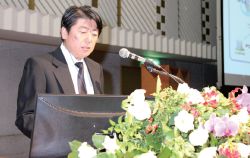
 Yuji Ito, President, FORUM8 Yuji Ito, President, FORUM8 |
The Entire Organization of the Festival and Positioning of Each Event
In this Design Festival, we had "the 4th Design Conference" on
Day1 organized by sessions of <Civil Engineering and Analysis>, <Architecture
/ BIM>, and <Hydraulic Engineering>, "VR Conference"
including "the 11th UC-win/Road Conference" and "the 4th
International VR Symposium" on Day2, and "the 9th 3D VR Simulation
Contest" on Day3.
The 4th Design Conference is based on "UC-win/FRAME (3D) Conference"
that started in October 2003 following the release of "UC-win/FRAME
(3D)" for three-dimensional (3D) dynamic nonlinear analysis. Since
2007, this has been enhanced and held at the same time with "UC-win/UC-1
User Conference", to form the present Design Conference.
UC-win/Road Conference started in 2000, when the 3D real time VR (Virtual
Reality) software "UC-win/Road" was released. It was expanded
to include "VR-Studio Conference" following the release of "VR-Studio",
3D large-scale multi VR in 2009, stepping into the 11th time this year.
|
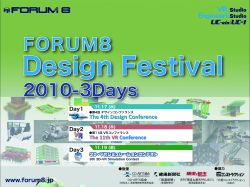 |
Exploring a new direction of 3D VR, a global network of architectural and
construction researchers "World 8" was organized in 2007. In
the same year, "International VR Symposium" got off the ground
as a place to present the research products. This year, the 4th Symposium
was held with the members doubled in number from the beginning, called
"World 16", though some of the members switched with others,
presenting and discussing the research products and ideas.
"3D VR Simulation Contest" was established when UC-win/Road received
"Software Product of the Year" in 2002. This year we organized
our 9th contest, presenting novel ideas, new technologies, or works that
reflect international colors.
The following is the summary and points of each event in the Design Festival.
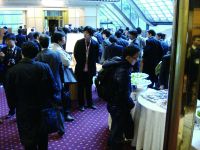 |
|
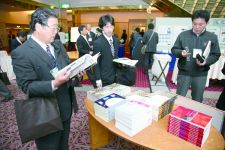 |
|
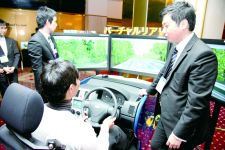 |
 The lobby was full of people all day long, where DS, RoboCarR was displayed
and books were available for purchase. The lobby was full of people all day long, where DS, RoboCarR was displayed
and books were available for purchase. |
|
|
| [Day1] The 4th Design Conference |
Three Sessions of <Civil Engineering / Analysis>, <Architecture
/ BIM>,
and <Hydraulic Engineering>
Introducing State-of-the-art Technologies Through Special Lectures by Expert
Researchers and Users in Each Theme
On the 1st day of "FORUM8 Design Festival 2010 ? 3Days", the
Organizer's greetings by our President Yuji Ito opened "the 4th Design
Conference".
Day1 Started with the Special Lecture "The Latest and State-of-the-art
Technologies of Civil Engineering and the Future Outlook"
| The Design Conference started with a plenary session. Mr. Masaaki Yabe,
Director, earthquake-resistant technology department, structural project
division, Chodai Co. Ltd. gave a special lecture entitled "The latest
and state-of-the-art technology of civil engineering and the future outlook:
design criteria, a large-scale model experiment for structural elements,
and a verification example using E-Defense". First, he talked about
the present situation of performance design, the reason why the allowable
values (design criteria) for earthquake-resistant design to secure quake-proof
performance in Specifications for highway bridges Part5 Seismic design,
then realization of performance design and criteria setting. Next, he explained
about the full-scale model experience for structural elements composing
highway bridges (reinforced concrete piers, single column/rigid-frame steel
piers, infrastructure, base-isolated bearings, a rubber extension device,
a bridge collapse prevention unit), and verification of design criteria
through experiments using E-Defense (reinforced-concrete piers designed
under the present Specifications for highway bridges, reinforced concrete
piers causing flexural failure designed using the former specifications,
RC piers of next-generation). Lastly, he mentioned expectation towards
experiments with E-Defense. |

 Mr. Masaaki Yabe, Director, earthquake-resistant technology department,
structural project division, Chodai Co. Ltd. Mr. Masaaki Yabe, Director, earthquake-resistant technology department,
structural project division, Chodai Co. Ltd. |
Following this, a FORUM8 staff member made a presentation "E-Defense
Blind Analysis Contest report: the newest functions of UC-win/FRAME (3D)
/ Engineer's Studio". The first half of the presentation included
the summary of "preliminary analysis of C1-6 experiment contest using
E-Defense" sponsored by National Research Institute for Earth Science
and Disaster Prevention, in which FORUM8 got the first prize in the rupture
analysis section as a joint team with Tokyo City University, the summary
of the analysis method and models used in the contest, points of the analysis,
comparison between the results of analysis and the experiments, and discussion
based on them. In the second half, the newest functions of UC-win/FRAME
(3D) and Engineer's Studio and their development plans in the future were
explained. In addition, the speaker mentioned "Concrete Column Blind
Prediction Contest 2010" in the USA, which FORUM8 participated recently.
From 1:00pm, technical sessions were carried out separately for 4 hours
and a half according to the three themes of <Civil Engineering / Analysis>,
<Architecture / BIM>, and <Hydraulic Engineering>.

 The venue for the main conference where Mr. Yabe gave his lecture was Maiogi,
a large-sized hall in Meguro Gajoen, which was almost full. The venue for the main conference where Mr. Yabe gave his lecture was Maiogi,
a large-sized hall in Meguro Gajoen, which was almost full. |
| Civil Engineering / Analysis session (Stream-1) |
The session in the afternoon got started with a special lecture entitled
"Let's play with numerical simulation! Structural analysis seen through
parametric study" given by Professor Hiromichi Yoshikawa, Earthquake
Risk Management Lab., Tokyo City University Advanced Research Laboratories.
First, he talked about the development of commercial software for structural
analysis and seismic design, and the advantage of improving efficiency
by using the advanced package software. After showing specific examples
of analysis by numeric simulation, he mentioned that it would be important
to create tables and figures of the analysis results. Next, he explained
case studies of using parametric study. Finally, he introduced a new publication
"Structural analysis with numeric simulation" and expected towards
super engineers who make free use of these advanced commercial software
and computer environment across the daily design tasks.
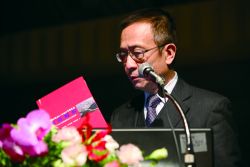
 Professor Hiromichi Yoshikawa, Earthquake Risk Management Lab., Tokyo City
University Advanced Research Laboratories Professor Hiromichi Yoshikawa, Earthquake Risk Management Lab., Tokyo City
University Advanced Research Laboratories |
The next special lecture was "Analysis examples of seismic performance
verification using FRAME3D" given by Mr. Makoto Kanai, Manager of
Analysis Dept., Applied Technology Co., Ltd. He explained about the expressions
of "Level 2 seismic vibration" and "a certain degree of
damage is allowable" described in the Guideline of seismic performance
verification for riparian structures (draft) developed by Ministry of Land,
Infrastructure and Transport (MLIT) in March 2007 and its commentary, as
well as nonlinear analysis that reflects them, modeling with beam elements,
and analysis using M-マ・roperty. Based on this, he further talked about
the features and cautions of UC-win/FRAME (3D) in verifying riparian structures.
He then described in detail the analysis case that he actually conducted
on a sluice / Watergate and a pumping station making full use of the effect.
He kept on talking about his view on the Guideline and riparian structures
and issues, the advantages of UC-win/FRAME (3D) there and his request for
improvement, and how they are doing in using it.
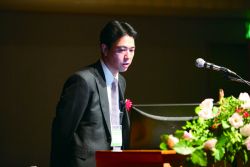
 Mr. Makoto Kanai, Manager of Analysis Dept., Applied Technology Co., Ltd. Mr. Makoto Kanai, Manager of Analysis Dept., Applied Technology Co., Ltd. |
The second half of the session was opened up by Mr. Haruhiro Hori, Deputy
Secretary of technology and Asset Management Dept, Sanyu Consultants Inc.
with a special lecture "Seismic verification method with response
displacement of a large-scale pumping station using Engineer's Studio and
UWLC". He proposed seismic countermeasure that helps reduce cost by
accurately grasping the greatest possible earthquake-resistant performance
of existing pumping stations instead of the current design criteria of
newly constructed structures. First, he expounded on the structure of a
large-scale pumping station and the characteristics of the construction
site, and the system of verification method. He said that the realistic
verification method for seismic design of underground structure is the
response-displacement method. As the methods for structural analysis, one-dimensional
effective stress analysis by UWLC was designated for ground motions analysis,
and three-dimensional elasto-plastic static analysis with Engineer's Studio
for structural analysis. After showing the structural analysis system and
the developmental concept of the verification system of seismic design
in consideration of nonlinear and elastic-plasticity, he presented specific
examples of analysis, analysis results, and his own evaluation through
them. He further talked about possibility of new approach and challenges.
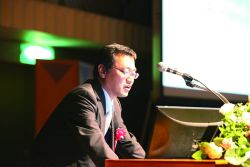
 Mr. Haruhiro Hori, Deputy Secretary of technology and Asset Management
Dept, Sanyu Consultants Inc. Mr. Haruhiro Hori, Deputy Secretary of technology and Asset Management
Dept, Sanyu Consultants Inc. |
Next, Professor Keizo Ukai, Graduate School of Gunma University gave a
special lecture entitled "Forefront of research on earthquake landslides:
numerical analysis of slope stability during earthquake and 3DVR simulation".
In the first half, he expounded on the investigation of the mechanism of
collapse by liquefaction that Professor Ukai conducted with UWLC over Chuetsu
Earthquake (Niigata Pref., 2004) and the analysis of countermeasure construction
for earthquakes and landslides. He then talked about the investigation
of the mechanism of debris avalanche that occurred in China (the Wenchuan
earthquake) and Indonesia (Cikangkareng). In the second half, Mr. Andhitiawarman
Nugraha, who works in the Indonesian branch of Japanese consultant firm
and is a graduate of the Gunma Univ., presented the process of producing
the animation that represents debris avalanche with 3D VR with its products.
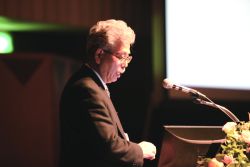
 Professor Keizo Ukai, Graduate School of Gunma University Professor Keizo Ukai, Graduate School of Gunma University |
Next, Mr. Toshihiro Hanada, President of Bulld Geotechno Co., Ltd. gave
a special lecture entitled "FEM stability analysis of a retaining
wall installed on the site of slope failure on soft ground". He presented
a ground analysis case conducted with GeoFEAS over the retaining wall planned
to construct on the soft ground that had slope failure due to a heavy rain.
He expounded the specific background of operation and the procedure of
FEM analysis, use of the analysis results and their problems, and his view
on GeoFEAS.
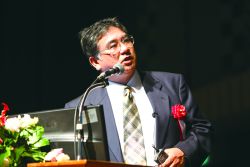
 Mr. Toshihiro Hanada, President of Bulld Geotechno Co., Ltd. Mr. Toshihiro Hanada, President of Bulld Geotechno Co., Ltd. |
The last presentation of the session was made by our staff member entitled
"The Newest functions and support for the new guideline for fill work
of Ground Analysis series". First, he explained about the points of
Fill work guideline revised in 2010 based on the revision of Highway earthwork
manual (2009), growing demands for FEM analysis of seepage flow caused
by this, functions of VGFlow 2D and its positioning in FORUM8's Ground
Analysis series. Next, he expounded on the functions of GeoFEAS 3D Ver.2
that was mounted and strengthened in the new edition, product makeup and
functions of newly developed "Falling rocks simulation", and
3D visualization of the analysis results linked with UC-win/Road.
| Architecture / BIM Session(Stream-2) |
The latest research of 3D evacuation analysis using elevator was explained.
Evacuation model of the venue using EXODUS
The Architecture / BIM Session started with the special lecture of Mr.
Ed. Galea, Professor of FSEG (Fire Safety Engineering Group), University
of Greenwich, who developed the advanced evacuation modeling software "EXODUS"
and the fire modeling software "SMARTFIRE" from the afternoon
in "Hanautage" as well as the Civil Design / Analysis Session.
Mr. Galea presented the research result of his specialty area, "Fire
safety" and the latest development in the field of evacuation modeling
with case examples such as airport and hospital. In the example, the simulation
of the impact of evacuation sign on the evacuation behavior was introduced.
In addition, he mentioned about the new version of EXODUS to be released
in 2011, focusing on the merge function for each floor of the building
with the escalator model, the simplification of spatial concept in room
unit, the support for continuous node models, and the modeling / analysis
with the mixture of these functions. As for the 3D analysis research of
FSEG, he presented various verification of evacuation method with the research
results of elevator modeling and the use of elevator in evacuation behavior.
Lastly, the lecture ended with an introduction of the evacuation model
of the lecture room, "Hanautage" in Meguro Gajoen".
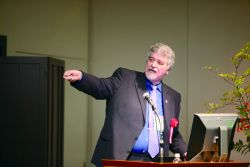 |
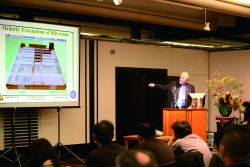 |
 FSEG, University of Greenwich, Professor, Ed.Galea FSEG, University of Greenwich, Professor, Ed.Galea |
Verification of the use of photo luminescent tape for evacuation guidance
using VR whilst preserving the architectural design
Next, the special lecture "Evacuation guidance system, SWGS-light
storage type" by Mr. Yukio Ota, administrative director of NPO Sign
Center was held. Mr. Ota has been involved with the establishment of a
standard for the evacuating guiding system and he introduced the background
of the emergency exit sign, various kinds of sign such as the evacuation
in wide area or tsunami case, and the related experiments. He said "It
is important for the evacuation sign to be standardized with pictogram
so that everyone can recognize it in one glance.
As for the evacuation guidance using photo luminescent tape, he mentioned
"The 10 centimeters wide tape based on the standard in USA negatively
influenced the design of building" and suggested an alternative proposal
to cause minimum disruption to the existing design. It was demonstrated
that 2.5 ? 5 centimeters of tape width could balance functionality and
design as well as play the role of evacuation guidance through the verification
in VR.
At the end of lecture, he introduced the movie of VR data created by UC-win/Road
which describes the prototype of evacuation guidance with the narrow type
of photo luminescent tape. It was visualized that both of architectural
design and evacuation guidance could be performed simultaneously.
 |
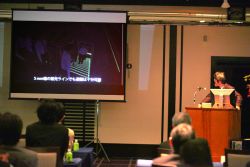 |
 NPO Sign Center, Yukio Ota NPO Sign Center, Yukio Ota |
Trend of developing BIM related field and case studies of Japan and abroad
were presented
The contents of the latter half of this session were about the latest technology
using BIM (Building Information Modeling) method and the case examples.
At first, it started with the lecture "Build Live Tokyo 2010 (BLT2010)
and the latest information of BIM" by Mr. Junichi Yamashita, IAI Japan.
He explained how BIM affects the construction process by introducing the
activity of IAI, the BIM design competition "BuildLive Tokyo",
and the current condition of BIM guideline in each country.
He mentioned that the BIM / IFC were likely to be required in each country
and he explained that the data format of IFC and BIM had to be used for
submitting in the open competition of the national museum design in Oslo,
Denmark and 1,300 of works were applied in this data format.
For foreign examples, he mentioned the BIM implementation planning in the
US Army Corps of Engineers. The National BIM Standard (NBIMS) was established
and it was aimed to be perfectly implemented by 2012. "Cobie Project"
which benefited from it was introduced.
The Cobie project involved the submission and linkage of BIM data with
FM management. Previously, the information was exchanged based on the paper
format. He explained that the project is intended to streamline the process
at the management step by replacing the existing method by the digital
information with BIM data. The wide range of information of BIM from the
trend of Japan to abroad was provided through the lectures.
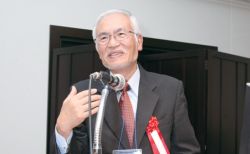 |
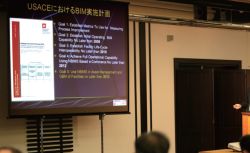 |
 IAI Japan, Junichi Yamashita IAI Japan, Junichi Yamashita |
 |
 Attentive attendees listened in anticipation and keen interest. Attentive attendees listened in anticipation and keen interest.
ssThe questions and answers on the future development of architecture /BIM
were actively carried out. |
The explanation of the latest function of BIM related software with the
report of Build Live Tokyo 2010
After the lecture of Mr.Yamashita, our staff made the presentation on BIM
products.
Firstly, "Build Live Tokyo 2010" which was held in November 2010
where FORUM 8 participated as "TeamF8W16" was reported. This
is the BIM design competition organized by Japan IAI as explained in the
lecture of Mr. Yamashita. Allplan was used as BIM platform and the data
of various FORUM8 products were linked with them to consider the planning
by simulation. It was introduced that the VR data of each planning step
was opened via cloud service "UC-win/Road for SaaS" so that anyone
could easily join in the process of the consensus building.
The case examples of evacuation and fire modeling software "EXODUS/SMARTFIRE"
which was used for the crowd simulation of building model in Build Live
Tokyo 2010.
Next, the latest function of BIM integrated solution "Allplan"
and building energy analysis software "Design Builder" were presented.
As for Allplan, it was explained the effective 3D bar arrangement simulation
with the support for the timber building and the improved function of quantity
takeoff, and the linkage with our UC-1 Series CAD integrated products such
as "Bridge Pier Design".
At the end of this session, the new version of "Underground parking
design" and "Design calculation of architectural pile foundation"
and the latest information of UC-1 architectural design solution were presented.
 |
 VR data for Build Live Tokyo 2010 VR data for Build Live Tokyo 2010 |
| Hydraulic Engineering Session(Stream-3) |
Valuable occasion for the discussion of the existence of water in the urban
area
The Hydraulic Engineering Session also served as the third xpswmm user
meeting (organized by SWMM user group, supported by NPO Water Environment
Construction Club, FORUM8, XP-software Pty Ltd.) The chairman of user group,
Professor Yoshihisa Kawahara, Hiroshima University Graduate School made
an opening speech and mentioned that this session would be valuable occasion
to discuss the existence of water in the urban area as a number of problems
of the water amount and water quality occurred by the guerrilla heavy rain.
Professor Kawahara made a presentation with the theme of "The latest
rainstorm disaster and the future development of the flood inundation analysis
technologies" after his speech. He explained the type of heavy rain
disaster, the reason, and the outbreak mechanism of heavy rain and he raised
the damage example of the guerilla heavy rain as the characteristic of
the recent rain disaster.
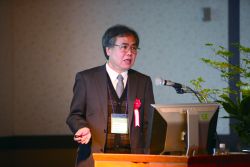
 Professor Yoshihisa Kawahara, Hiroshima University Graduate School Professor Yoshihisa Kawahara, Hiroshima University Graduate School |
The special lecture "Evaluating microorganism contamination by combining
the result of urban flood analysis and water quality test" by Professor
Hiroaki Furumai, Graduate school of engineering, University of Tokyo followed.
The five points of views, river improvement, water utilization, hydrophilia,
maintenance of aquatic ecosystem, and the management of heat via water
were explained. As the case study of xpswmm the urban flood analysis for
Hanoi city, Vietnam was featured and it was mentioned that there was a
match between the actual record of flood and the simulation results.
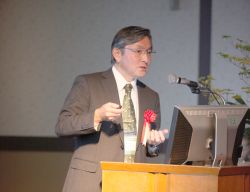
 Professor Hiroaki Furumai, Graduate School of Engineering, University of
Tokyo Professor Hiroaki Furumai, Graduate School of Engineering, University of
Tokyo |
Panel discussion where various speakers with different background such
as river and sewerage gathered together
In the latter half of the session, it started with the special lecture
of Professor Masaru Morita, Shibaura Institute of Technology "Risk
management of rainwater drainage and flood in the urban area". Mr.
Morita indicated the concept of the risk management of disaster prevention,
reduction, and flood and he mentioned the background of the model until
the current advanced analysis theory was established as the history of
runoff analysis model.
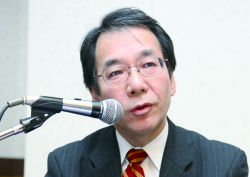
 Professor Masaru Morita, Shibaura Institute of Technology Professor Masaru Morita, Shibaura Institute of Technology |
The next presentation was conducted by Dr. Ashis Dey, XP-software with
the theme "Analysis of hydraulic design series and UC-win/Road for
xpswmm". He mentioned that the challenge in modeling with 1D analysis
theory, 2D analysis theory, and the mixture of 1D/2D.
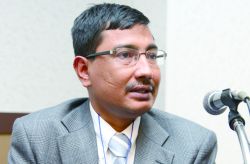
 Dr. Ashis Dey Principal, XP-software Pty Ltd. Dr. Ashis Dey Principal, XP-software Pty Ltd. |
At the end, the special lecture "Utilization of runoff analysis model"
was performed by Takateru Ishikawa, NPO Water Environment Construction
Club with the panel discussion. The speakers of this session, Mr. Kawahara,
Mr. Furumai, Mr. Morita, Mr. Dey were participated in the discussion as
the panelist and the following four themes were discussed: "Interpretation
of effective rainfall (effective rainfall and runoff coefficient)",
"Rainfall size and application model (1D model and 1D / 2D model)",
"Enhancement of the applied range (Maintenance for rainfall and flood
damage)", "Utilization of runoff analysis model (Rainfall countermeasure
and utilization of model)". Under Mr. Ishikawa's lead, active discussions
from different viewpoints pertaining to different backgrounds such as river
and sewerage were carried out together with the opinions from the general
audience.
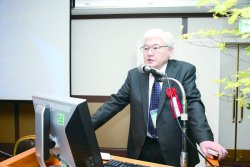
 Mr. Takateru Ishikawa, NPO Water Environment Construction Club Mr. Takateru Ishikawa, NPO Water Environment Construction Club |
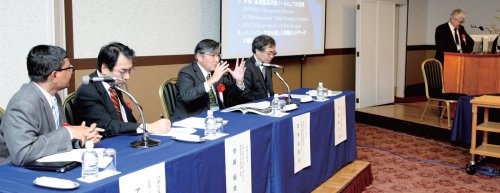
 Panel discussion with the theme of "Utilization of runoff analysis
model" Panel discussion with the theme of "Utilization of runoff analysis
model" |
|
| [Day2] The 11th International VR Conference |
"The 11th UC-win/Road Conference" and "The 4th International
VR Symposium" were held on Day2
With "Technical Support Session" by our development engineers
| On the second day, the 11th UC-win/Road Conference and the 4th International
VR Symposium started in the space separated from the large room from morning.
UC-win/Road Conference progressed with two sessions, Main Session and Driving
Simulator Session from afternoon. With the technical support sessions held
in different rooms, our development engineers were able to take care of
customers with various solution queries including UC-1, UC-win, and BIM&VR. |
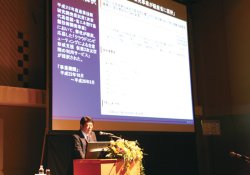
|
Firstly, "Current condition of development and future expansion of
UC-win/Road Ver.5 and VR-Studio" was presented by FORUM8 staff. It
was introduced in the case studies of system development, the project adopted
by METI (Ministry of Economy, Trade and Industry) "Consensus formation
support via cloud computing", the new services in 3D scan, point cloud
modeling, and 3D modeling with the new functions of UC-win/Road Ver.5.
In addition, the expansion of cloud SaaS function, the movement of pedestrian
crowds, FBX animation, the sliding type of presentation function were mentioned
as the development for Ver.6. Finally, the new functions and current development
condition of VR-Studio? Ver.1.3 were introduced alongside with the demonstration
of the latest features such as intersection and traffic functions.
Case studies of UC-win/Road and VR were presented by different type of
professionals
The first speaker of the afternoon special lecture was Mr. Philippe Marsaud,
Technical manager of BMIA in France, who has been involved in the consultancy
works of monitor and control system for fifteen years. He explained the
advantage of linking monitoring system SCADA with UC-win/Road with the
theme "Uses of UC-win/Road in a 3D simulation software for training
Road and Tunnels operators". He said "The first version of this
system made use of a game engine but the representation was not realistic
hence I decided to adopt UC-win/Road. We will expand the system with the
use of plug-in and spread the complete system for the tunnel management
both in and out of France in future."
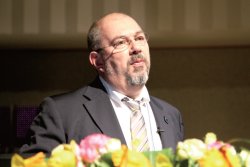
 Mr. Philippe Marsaud, Technical manager, BMIA Mr. Philippe Marsaud, Technical manager, BMIA |
Next, in the special lecture by Professor Lee Dongmin, Korea Transport
Institute (KOTI) "Traffic studies considering the aspect of traffic
users" followed. He talked about the driver's perception and traffic
system and he explained that three factors: user, vehicle, and environment
interlock. He said that the VR allows the quick judgment and action through
clear perception and he found it is suitable for the measurement of driver's
perception. He also mentioned this method would be useful for clarification
and research of driver's thinking process. The actual case study of UC-win/Road
was introduced via movie and the effectiveness of UC-win/Road for clarification
of driver's perception was explained.

 Professor, Lee Dongmin, Korea Transport Institute (KOTI) Professor, Lee Dongmin, Korea Transport Institute (KOTI) |
Professor Nashwan Dawood, Teesside University in UK lectured on the theme
"Energy analysis and reduction in the built environment: the case
for BIM and visualization technologies" and he introduced the utilization
of ICT (BIM, integrated database, visualization technologies, and GIS)
for the building environment. He mentioned that it is used for the existing
buildings and it is aimed that about 20 percent of CO2 would be reduced.

 Professor, Nashwan Dawood, Teesside University Professor, Nashwan Dawood, Teesside University |
The first speaker of the latter half of the session was Mr. Michael Manore,
TRB Visualization in Transportation Committee with the theme of "The
growth of the 3D visualization Market in the USA". Mr. Manore, who
has been involved with the visualization of the civil engineering design
for a long time, introduced the intelligent bridge with the sensor such
as temperature and vibration.
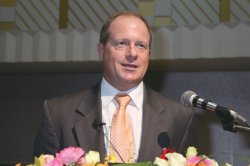
 Mr. Michael Manore, TRB Visualization in Transportation Committee Mr. Michael Manore, TRB Visualization in Transportation Committee |
Next up was the special lecture of Mr. Keiichi nishikawa, LBS project manager,
RFID LBS system engineering center, Electronic system project department,
Mitsubishi Electric Corporation lectured with the title of "Modeling
using data measured by MMS for maintenance management". The VR data
of "Umihotaru" with the point cloud measurement and the system
which allows the detection of the traffic sign and manhole and transformation
to the ledger was introduced. The void and the point to be repaired can
be specified through the linkage of underground radar with MMS and it can
be used for the checking and maintenance of the tunnel.
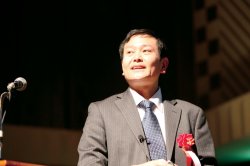
 Mr. Keiichi nishikawa, LBS project manager, RFID LBS system engineering
center, Electronic system project department, Mitsubishi Electric Corporation Mr. Keiichi nishikawa, LBS project manager, RFID LBS system engineering
center, Electronic system project department, Mitsubishi Electric Corporation |
At the end of this session, our staff explained the function of UC-win/Road
point cloud plugin and 12D Model plugin following the lecture of Mr. Nishikawa
and demonstrated these features.
| Driving Simulator Session |
The first special lecture of DS session was conducted by Associate Professor
Muneo Yamada, Meijo University with the theme of "Utilization of driving
simulator for detecting driver's condition". Regarding the traffic
accident and its main cause, driving capability (perception, judgment,
and operation), he explained the detection method of the depressed consciousness
and the existing waking method, the waking method with "the supply
of fragrance" under investigation and he also reported on the experimental
results of the detection.
Vibration, gum, coffee, and buzzer sound were used for the existing research,
but he mentioned "we focused on the olfactory stimulation by supplying
the fragrance which doesn't interfere with the driving action" for
this time. Regarding the measurement system of driving capacity for the
aged driver, he explained the experimental result from two points of view,
available view and perception/judgment.
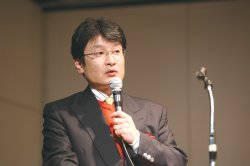
 Associate Professor, Muneo Yamada, Meijo University Associate Professor, Muneo Yamada, Meijo University |
Next, the special lecture of Mr. William L. Curtice, VSAT USA (Virtual
Simulation & Training Inc.) followed with the title of "Research
to define driving simulator performance and vehicle dynamics fidelity requirements
for training driving skills". He has involved in the virtual simulator
for training from the military forces to driver in VSAT after developing
the training system in US Air Force for 37 years. Based on the experience,
he explained the training theory and method. "The age doesn't affect
the training result but the empirical value (driving experience) does."
he mentioned. He emphasized the importance of a lot of training and having
the survival techniques for the improved driving. Moreover, he also mentioned
the availability for the training simulator for the UC-win/Road Ver.5 high
quality dynamics.
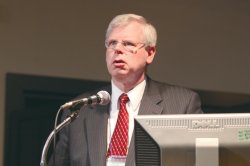
 Mr. William L. Curtice, vice president of VSAT Mr. William L. Curtice, vice president of VSAT |
Following the lecture of Mr. Curtice, our staff presented on "UC-win/Road
Ver.5 Driving Sim functions". As well as the engine and suspension
function of vehicle moving model, he mentioned the detailed setting of
vehicle allows the realistic simulation by the linkage with CarSim. In
addition, he introduced the scenario function and ECO drive in addition
to the sound system, each simulator, and cluster function.
In the latter half of session, two presentation in the development of carrobotics
platform, RoboCar(R) followed. The special lecture was performed by Ms.
Yoko Imanishi, ZMP Inc. with the theme of "RoboCar(R) and VR which
accelerate the research and development of next generation mobility, EV".
In addition to the actual vehicle sized of very small electronic vehicle,
RoboCar(R) Micro EV, the features and functions of 9 axis motion sensor,
CO2 sensor, and wireless electrocardiographic were introduced. Moreover,
the usage example and the introduction example of scale model car were
presented and the demand and background until RoboCar(R) and VR solution
are linked were explained.
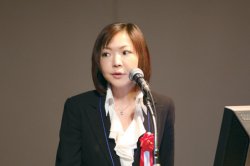
 Ms. Yoko Imanishi, new project development department, ZMP Inc. Ms. Yoko Imanishi, new project development department, ZMP Inc. |
In the next presentation, the current and the future development of RoboCar(R)
and UC-win/Road for RoboCar(R) using MindSet & VR and AURELO(AUgmented
REality LOcalization system) were introduced by our development staff.
The 4th International VR Symposium
"VR Opens Up ICT Innovation" - World 16 Presents Research Products
of 2010
Before presentations by the members of World 16, The 4th International
VR Symposium got started with speech by Dr. Yoshihiro Kobayashi, Prism
Lab. Research Associate, School of Computing, Informatics, and Decision
Systems Engineering, Arizona State University/ FORUM8 AZ CEO & President,
who had been leading this activity from the beginning. He talked about
the goals and missions of World 16 and the past activities, and then introduced
the members of this time.
| Presentations of World 16 |
The first presentation was made by Prof. Thomas Tucker, Assistant Professor,
Department of Fine Arts, Winston Salem State University, entitled "Reconstruction
of the Al Bastakiya Cultural Quarter". In collaboration with Prof.
Ronald Hawker, Associate Professor, Dubai Campus, Zayed University and
others, he aimed to represent Al Bstakiya cultural district using VR with
the students of each universities. He expounded the processes of modeling
buildings, people, animals, and ships in conformity with tradition and
animating them.
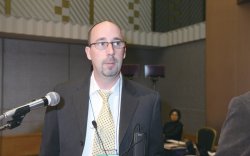 |
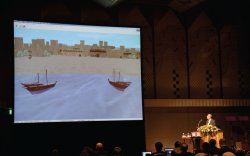 |
 Prof. Thomas Tucker, Winston Salem State University / USA Prof. Thomas Tucker, Winston Salem State University / USA |
Prof. Michael Jemtrud, Associate Professor of Architecture, Director, School
of Architecture, McGill University (Canada) made a presentation about "Using
UC-win/Road to support public engagement and participatory design on major
city-building project" that he works jointly with Instructor Heather
Braiden and others. He reported on a project of designing the area in the
city of Montreal where infrastructural facilities such as railroads, expressways,
and canals converge in cooperation with residents. In this process, he
aimed to build environmental models to obtain consensus of various stakeholders
using UC-win/Road. He presented the activities and results so far.
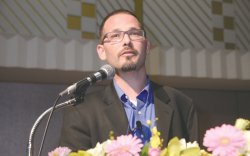 |
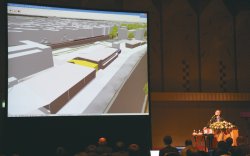 |
 Prof. Michael Jemtrud, McGill University / Canadad Prof. Michael Jemtrud, McGill University / Canadad |
Prof. Wael Abdelhameed, Assistant Professor, College of Engineering, University
of Bahrain made a presentation on his joint research "VR applications
in project management (PM): scheduling and reporting". First, he summarized
the concept of PM and the related tools and then showed the simulation
of the project for which he used VR for scheduling and reporting. He mentioned
comparison with GIS, advantages and potential of VR, and challenges.s
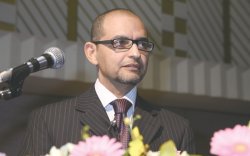 |
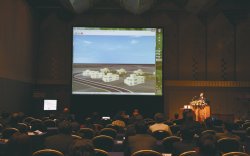 |
 Prof. Wael Abdelhameed, University of Bahrain / Bahraind Prof. Wael Abdelhameed, University of Bahrain / Bahraind |
As the last presentation in the morning, Tomohiro Fukuda, Associate Professor
of Environmental Design & Information Technology, Division of Sustainable
Energy & Environmental Engineering, Graduate School of Engineering,
Osaka University made a presentation "Development of optimizing system
from 3D laser scanner data to VR for urban design study". This is
to create digital data out of a physical scale model using 3D laser scanner.
He expounded the system developed for representing faces and edges clearly
while reducing the data amount. He then demonstrated the result linked
with UC-win/Road.
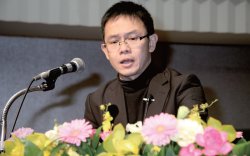 |
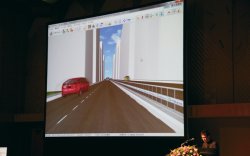 |
 Prof. Tomohiro Fukuda, Osaka University / Japan Prof. Tomohiro Fukuda, Osaka University / Japan |
In the afternoon, Prof. Marc Aurel Schnabel, Associate Professor, School
of Architecture, the Chinese University of Hong Kong made the first presentation
entitled "Touching the untouchable: immersive virtual design studio".
In exploring approaches to communicating on design, he paid attention to
the method using VR. He talked about its overview, possibilities that emerged
from that, his idea and challenges towards the future development.s
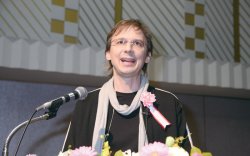 |
 |
 Prof. Marc Aurel Schnabel, the Chinese University of Hong Kong / Hong Kong Prof. Marc Aurel Schnabel, the Chinese University of Hong Kong / Hong Kong |
Next, Matthew Swarts, Research Scientist, College of Architecture, Georgia
Institute of Technology made a presentation "Isovist analysis realized
through point cloud visualization in UC-win/Road". He first expounded
on the mechanism of space recognition and recognizing techniques based
on them. As part of such research, he introduced model examples developed
using UC-win/Road development kit SDK. He is further planning to apply
it to constructing process to use for safety analysis and such.
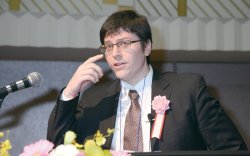 |
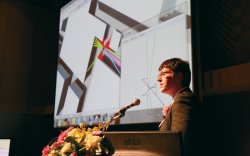 |
 Research Scientist Matthew Swarts, Georgia Institute of Technology / USA Research Scientist Matthew Swarts, Georgia Institute of Technology / USA |
Prof. Paolo Fiamma, Assistant Professor, Civil Engineering Department,
University of Pisa (Italy) made a presentation "Designing the interaction
between people and built environment in Italian historical city centers".
He created 3D models for the development project ongoing in the historical
urban area. Particularly focusing on constructing a parking lot, he made
a simulation of pedestrians' flow and its influence on the traffic. He
said that he would enlarge this method for the common issue among European
nations.
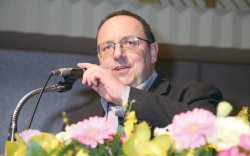 |
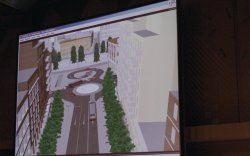 |
 Prof. Paolo Fiamma, University of Pisa / Italy Prof. Paolo Fiamma, University of Pisa / Italy |
Prof. Marcos Novak, Professor, Media Arts & Technology Graduate Program,
University of California, Santa Barbara made a presentation "Media
field navigation". As part of his own research on the fusion of art
and science, he expounded on the relationship between the physical brain
and the mental brain, and various art derived from that. In addition, he
envisaged development of navigation by interfacing UC-win/Road.
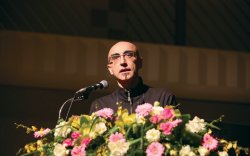 |
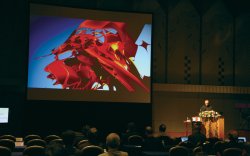 |
 Prof. Marcos Novak, University of California, Santa Barbara Prof. Marcos Novak, University of California, Santa Barbara |
As the last presentation of the first half of the afternoon part, Prof.
Taro Narahara, Assistant Professor, College of Architecture and Design,
New Jersey Institute of Technology, made a presentation "From visualization
to generative applications". After summing up his efforts of developing
a plug-in that enables real time interaction, he expounded a new point
of view that it would be used not only for visualization but also as an
active design tool. He presented an example of visualizing influences of
obstacles or intuitions on human behavioral patterns and representing them
in 3D on UC-win/Road. He also mentioned the future challenges relating
to human behavioral models and interface interaction.
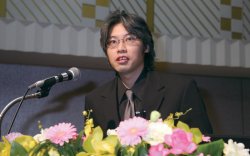 |
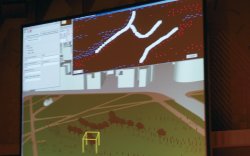 |
 Prof. Taro Narahara, New Jersey Institute of Technology Prof. Taro Narahara, New Jersey Institute of Technology |
After the break, Lecturer Amar Bennadji, School of Architecture and Built
Environment, Faculty of Design and Technology, Robert Gordon University
(RGU, UK) made a presentation "Traffic and Pollution control: remodeling
routes and access to RGU" As the campus of RGU moves, he made suggestions
for establishing a car park and a pedestrian crossover bridge in consideration
of the traffic and environment. He made a VR simulation of the influence
that they will have on the present congestion around Dee Bridge.
 |
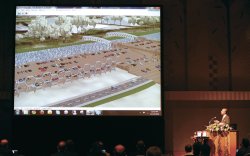 |
 Prof. Amar Bennadji, Robert Gordon University / UK Prof. Amar Bennadji, Robert Gordon University / UK |
Next, Prof. Kostas Terzidis, Associate Professor of Architecture, Graduate
School of Design, Harvard University made a presentation "Personal
informatics: Life paths". He expounded the idea of drawing the paths
selected by one's own sensibility. He mentioned the influences of environment
such as sound, sinarios, and VR images, saying that the paths drawn there
reflect him or herself and that it is important to transfer such information
into the world.
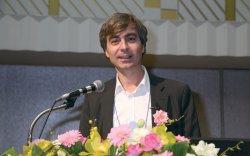 |
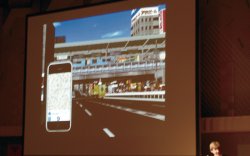 |
 Prof. Kostas Terzidis, Harvard University / USA Prof. Kostas Terzidis, Harvard University / USA |
The last presentation of World 16 was "City Design Generation without
Scripting" by Dr. Yoshihiro Kobayashi, the representative. He expounded
the past research progress and the outcome of development through World
16. He also explained his efforts of meeting the needs of generating city
models automatically in a short time.
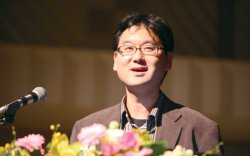 |
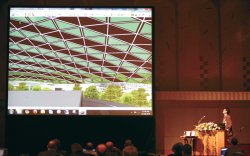 |
 Dr. Yoshihiro Kobayashi, Prism Lab. Arizona State University, Dr. Yoshihiro Kobayashi, Prism Lab. Arizona State University,
FORUM8 AZ CEO & President / USA |
After finishing all presentations, Academy prize for the research products
of World 16 was awarded to Prof. Thomas Tucker, Research Scientist Matthew
Swarts, Prof. Taro Narahara, and Prof. Amar Bennadji.
|
| [Day3] 9th 3D VR Simulation Contest |
Diversification, sophistication, and internationalization of the advanced
VR
FORUM8 held the 9th 3D VR Simulation Contest on the third day of "FORUM8
Design Festival 2010-3Days", November 19, 2010 in the large hall,
Maiogi, Meguro Gajoen.
As the contest which started when UC-win/Road received a prize of software
product of the year (2002) is the 9th in the series as well as this year
is 3 x 8 =24th anniversary for FORUM8, the contest was held in the gorgeous
site. UC-win/Road Ver.5 was released and the presentation which focused
on the new functions of the new version gained a fine reputation as the
maturity of VR grows.
 |
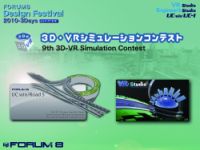 |
 Location : Maiogi, MeguroGajoen November 19, 2010 Location : Maiogi, MeguroGajoen November 19, 2010 |
For this time, in addition to the three judges, Mr. Hiroo Kasagi (NPO Chiiki
Zukuri Kobou), Mr. Fumio Seki (Taisei Corporation), Mr. Shinsuke Kitagawa
(Yachiyo Engineering), Mr. Yoshihiro Kobayashi (Prism Laboratory, Arizona
State University) was in charge of selecting committee. Before the final
judgement, the trial was implemented by above four selecting committee
on November 5. The top eleven works were nominated from a number of applied
works (6 from Japan, 5 from overseas).
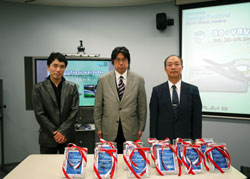 |
 |
 Announcement of the nominated works (November 2, 2010) Announcement of the nominated works (November 2, 2010) |
On the day of the contest, it started with the special invited speech of
Mr. Aidan Chopra, Google evangelist with the title of "Google and
the latest development information of SketchUp". The each presenter
of the nominated works made a presentation on their work for fifteen minutes
and the awarded works were decided by the votes of contest visitors and
judges.
When the final result was announced, Mr. Seki commented on behalf of the
judges. Each judge announced the special award and commented for it. Since
this time, the development award was added to the special judgment award
and it was announced by Mr. Yoshihiro Kobayashi.
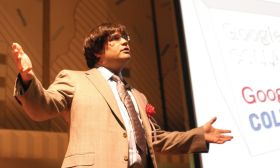 |
 |
 Mr. Aidan Chopra, Evangelist, Google Inc. Mr. Aidan Chopra, Evangelist, Google Inc. |
 Results announcement Results announcement |
When viewed throughout the contest, there were a variety types of models
including the model which represents theVR's speciality "Future"
to give the experience, and the models which represents the disaster occurred
in the "Past", however many of them were the one representing
"Present".It was focused that the work representing the sense
of living in the favorite town.
The each awarded works and their contents of the 9th "3D VR Simulation
Contest" are presented from the next page.
"Proposal of underground installation of Hanshin expressway and improved
city using VR"
Faculty of Policy Studies, Kansai University |
|
|
| The underground installation of Hanshin expressway is visualized to illustrate
the beautiful landscape in the urban area, secure green and pedestrian
space and to maintain the wide city space while proposing for the improvement
of OSAKA city. It is used to discuss in a wide range of issues relating
to reorganization. In addition, the analysis of traffic or pedestrians'
movement and disaster are performed considering different time frames.
Consideration of space reallocation to maximize utilization of the city
in the future was also carried out. |
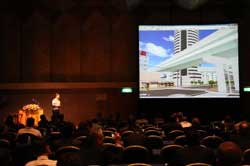 |
|
|
|

 Buried underground Buried underground |

 Current state Current state |

 Buried underground Buried underground |

 Current state Current state |

 Buried underground Buried underground |

 Current state Current state |

 Buried underground Buried underground |

 Current state Current state |

 Buried underground Buried underground |

 Current state Current state |

 Buried underground Buried underground |

 Current state(Point cloud data) Current state(Point cloud data) |

 Current state(Point cloud data) Current state(Point cloud data) |

 Current state(Point cloud data) Current state(Point cloud data) |

 Current state(Point cloud data) Current state(Point cloud data) |
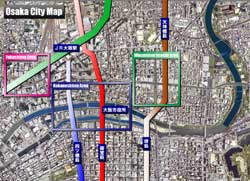
 Planning Area Planning Area |
|
|
"Highway driving simulator system"
East Nippon Expressway Co., Ltd |
|
|
| Events with potential danger on the expressway was represented in VR to
illustrate safe driving through the evaluation and analysis of the experience
drive behavior. The advanced reality was sought for the road structure
such as road accessories (signs), building, plant, vehicle movement. The
result of experience driving data is stored and analyzed to be used for
safe driving. |
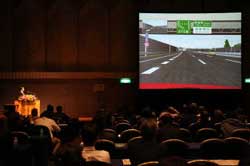 |
|
|
"Debris avalanche simulation"
Faculty of Engineering, Gunma University |
|
|
| A large-sized debris avalanche occurred in Cikangkareng due to the earthquake
(M7.3) in the off Indian Ocean, the west of Java. This avalanche was simulated
in 3D VR in the inhabitant workshop to investigate the actual condition.
In addition, the mechanism of debris movement is represented in a 3D environment
to illustrate the opinions of geology experts for the proposal of various
effective uses. |
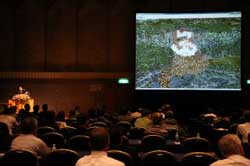 |
|
|
"STRIDING AHEAD! Modeling Unpredictable Pedestrian Road Crossing Behavior"
Abley Transportation Consultants Limited (New Zealand) |
|
|
| Iiam Road is located in a residential area of Christchurch and provides
access to the University of Canterbury. Due to its close proximity large
numbers of pedestrians walk along and cross Iiam Road, often informally
taking the quickest routes. Safety and efficiency concerns have lead to
the need for a redevelopment of Ilam Road. In order to represent the nature
of university students who tend to cross the road at random locations rather
than using formalized crossings the UC-win/Road Micro simulation player
plugin was used in conjunction with an S-Paramics model and the S- Paramics
plugin. |
 |
|
|
"A publicity drive simulator for EV and charging system in SmartGrid"
SK Energy Co., Ltd. (Korea) |
|
|
| The public facility is constructed in Jeju island, Korea, where the large-sized
experiment of SmartGrid is conducted. SmartGrid, which produces the battery
for electronic vehicles made use of the VR system in UC-win/Road to develop
an experience drive simulator. This simulator searches the area for battery
charging locations while driving in the EV vehicle environment. |
 |
|
|
 
Judges
Mr. Hiroo Kasagi, NPO Chiiki Zukuri Kobou
Mr. Fumio Seki, Taisei Engineering Co., Ltd.
Mr. Sinsuke Kitagawa, Yachiyo Engineering Co., Ltd.
Dr. Yoshihiro Kobayashi, Prism Lab. Arizona State University,
FORUM8 AZ CEO & President / USA |
|
 |
Artistic Award
Mr. Sinsuke Kitagawa, Yachiyo Engineering Co., Ltd. |
"VR simulation for the proposal of the ground facilities construction"
Asunaro Aoki Construction Co., Ltd |
|
|
| The simulation is performed from various types of view point including
player, trainer, inhabitant, facility manager, and observer for the construction
of the new ground in the university. UC-win/Road is created to share the
completed image and provide the exercise environment which meets the surrounding
environment. |
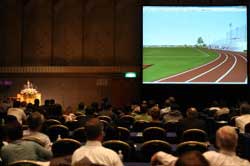 |
|
|
 |
Regional Construction Award
Mr. Hiroo Kasagi, NPO Chiiki Zukuri Kobou |
"VR simulation of the crosswalk construction planning for the prevention
of traffic accidents"
Korea Transportation Safety Authority(Korea) |
|
|
| Analysis of accident locations where 6 fatalities occurred were marked
over a period of five years and it was found that the reason behind accident
occurrences was due to the distance of crossing, vehicle speed and slope
gradient. Several projects were implemented for the safety issues including
the construction of pedestrian road. This content was created in VR data
to facilitate in the explanatory meeting with the residents. The features
of this work include the surveying of location of the street lighting during
night time, placement planning and the design considerations of a central
island. |
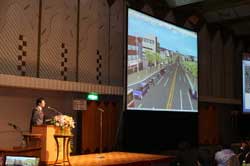 |
|
|
 |
Design Award
Mr. Fumio Seki, Taisei Engineering Co., Ltd |
"VR utilization for consensus-building toward landscape formation
of design city, Kobe"
Directorate general for Kobe city planning |
|
|
| It is essential to create interest in Kobe city to maintain and build the
landscape by covering a variety of landscapes ( sea, slope, and mountain).
The exotic city is introduced by the exploration of the city model. The
continuous model creation is carried out in the citizen participation workshop.
In addition, it is used as a supporting tool for landscape consultation
of building design and the regulation induction including height. |
 |
|
|
"VR data utilization and DS driving analysis system"
Taisei Engineering Co., Ltd |
|
|
| The comparison of the driving route and the creation of supplementary documents
are performed for Tomei expressway (which was in service since this spring)
as well as the new route of Atsugi IC - Capital central road/Ebina IC.
In addition, VR was used for the acquisition of the driving data from DS,
output and analysis of the data, measurement of the driver's judgment time,
verification and analysis of vehicles. |
|
|
|
"BANJAR Water Park"
FUJICON PRIANGAN PERDANA, PT (Indonesia) |
|
|
| "BANJAR Water Park" is the facility to be constructed by BANJAR
city, Indonesia. The planning is proceeded as a large-scaled amusement
pool for a number of tourists from domestic and overseas. The completed
image and the access to the facility are represented in VR in this data.
In addition, the image of visitors are playing in the pool can be experienced
from the view of the visitors. |
|
|
|
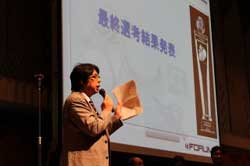 |
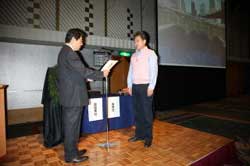 |
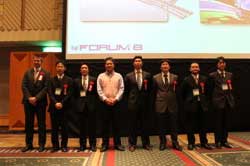 |
 Final Results annoucement Final Results annoucement
(Mr. Fumio Seki) |
 Awarding ceremony Awarding ceremony |
 Photo shoot of award winners Photo shoot of award winners |
|
|
|
|